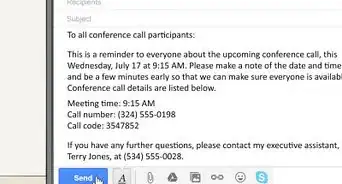wikiHow is a “wiki,” similar to Wikipedia, which means that many of our articles are co-written by multiple authors. To create this article, volunteer authors worked to edit and improve it over time.
This article has been viewed 133,275 times.
Learn more...
A management case study contains a description of real-life management issues and proposed solutions. Students, practitioners and professionals write case studies to thinking critically about issues, and devise and implement remedies for challenging management situations. A case study generally contains facts, theories, assumptions, analysis, and prioritized solutions. The following are the steps for writing a management case study.
Steps
Identify the Objective, Method and Facts
-
1Determine the main objective of the case study. You may be writing a case study to fulfill an academic requirement or to help solve problems in real-life situations. An academic assignment typically will come with a specific objective and instructions, whereas a professional assignment might require you to define the objective.[1]
-
2Select the best approach.[2]
- Choose an analytical approach to increase awareness. In the preliminary stages of solving management problems, an analytical case study might best meet the goal of alerting upper management to core facts and issues. An analytical case study primarily focuses on what has occurred and why.
- Select a problem-solving approach to pinpoint and solve major issues. If the goal is to make solution recommendations, write a problem-solving case study that clearly outlines problems and solutions.
Advertisement -
3Conduct research for your case study. Examine the facts, dynamics, communications and all relevant aspects of the particular situation. Research might involve interviewing people in an organization, reviewing written documents or looking up relevant statistics.
Set the Scope for Readers
-
1Explain the aim of the case study in the opening paragraph. The goal may be to understand the challenges of an organization or to solve interdepartmental conflicts.[3]
-
2Provide an industry or company overview. Certain facts or challenges may be common in the particular industry. For example, software bugs may be a common problem in the technology industry, requiring extensive product testing and quality control teams. Explain relevant factors to readers.
-
3Outline relevant theories and knowledge. Case studies for academic programs typically require reference to theories and information presented in class. Refer to these theories and explain their relevance to solving the real-life issues in the case. For example, a theory may be that training employees in too large a group leads to less individualized attention and inadequate skills mastery.
Focus on Issues and Solutions
-
1Identify all relevant issues. If many issues exist, focus on the most important ones. Some issues may be caused by underlying problems. For example, conflicts between team members may be due to unclear workplace policies or employee responsibilities.
-
2Recommend solutions. List the most effective solutions first and explain how they will solve core issues.
- Address the challenges that might accompany suggested solutions. For example, cross-cultural conflicts in an organization might require additional training for managers, which may require funds or an extensive search for topic experts.
Provide a Clear Conclusion
-
1Write a conclusion that summarizes the main issues and solutions. Emphasize the most effective recommendations.[4]
-
2Include a reference to relevant management theories. Explain in a few sentences how these theories support your conclusions.
Cite References
-
1Include a list of references. Cite sources for all statistics, definitions, facts and other research.[5]
-
2Follow the required citation format. Check with your professor or manager, and/or review prior case studies in your workplace to identify the required citation format.
Community Q&A
-
QuestionI need an example of managerial skill in a project assignment. What is a good one?
 Community AnswerPlanning -- List out steps needed for the assignment, include your own tasks and those of others, and show what tasks depend on what other tasks. Show who needs to complete the tasks that are not yours, show due dates for tasks, and negotiate these with others involved.
Community AnswerPlanning -- List out steps needed for the assignment, include your own tasks and those of others, and show what tasks depend on what other tasks. Show who needs to complete the tasks that are not yours, show due dates for tasks, and negotiate these with others involved.
References
- ↑ https://www.wordstream.com/blog/ws/2017/04/03/how-to-write-a-case-study
- ↑ https://www.wordstream.com/blog/ws/2017/04/03/how-to-write-a-case-study
- ↑ http://www.ntu.edu.vn/Portals/96/Tu%20lieu%20tham%20khao/Phuong%20phap%20giang%20day/case%20writing%20manual.pdf
- ↑ https://libguides.usc.edu/writingguide/casestudy
- ↑ http://www.ntu.edu.vn/Portals/96/Tu%20lieu%20tham%20khao/Phuong%20phap%20giang%20day/case%20writing%20manual.pdf
- http://monash.edu/lls/llonline/quickrefs/27-case-study.pdf
- http://www.schreyerinstitute.psu.edu/pdf/CaseWritingGuide.pdf
About This Article
To write a management case study, first give a clear industry overview of the problem and explain theories and current knowledge. Next, pinpoint all the important issues and identify any underlying problems. For example, conflicts between team members might stem from unclear workplace policies. Finally, generate effective solutions and explain why they will work. Wrap it up with a conclusion that summarizes the problems and solutions you discussed. Read on for more details on how to conduct research for a management case study and cite your sources.






































































